KIRKCUDBRIGHT
Population : 2,101.
Early Closing Day Thursday at 1 o’clock.
Market Day: Friday.
Miles from London (Euston or St. Pancras, via Carlisle and Dumfries); 363.
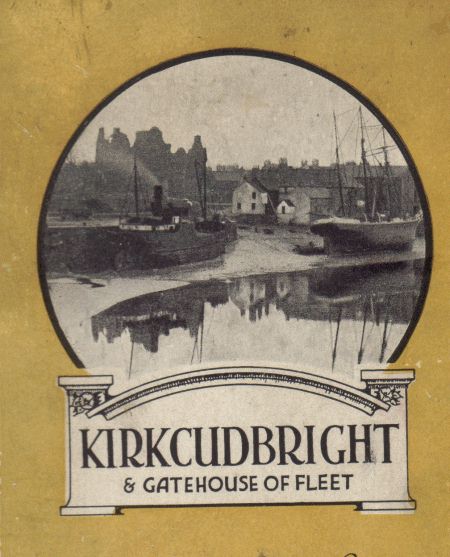
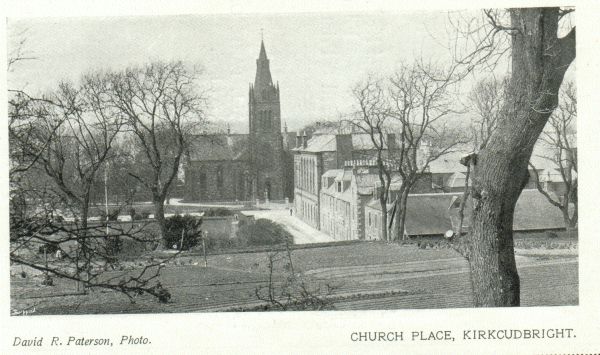
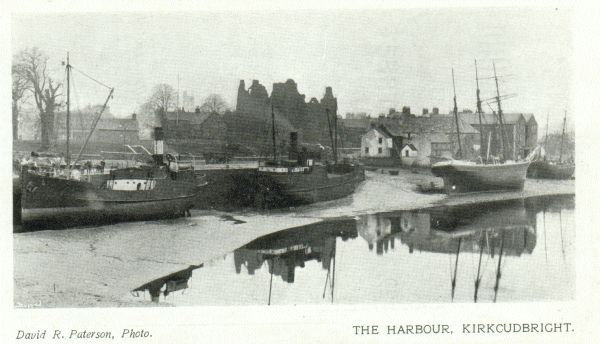
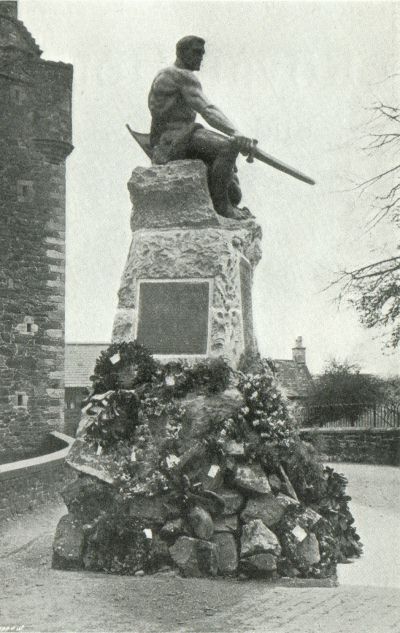
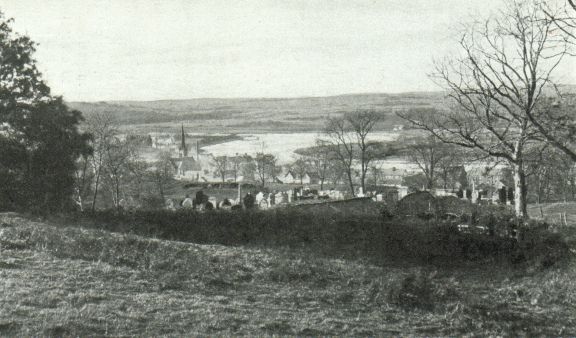
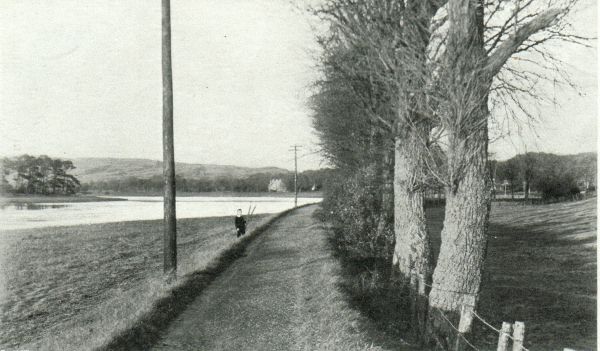
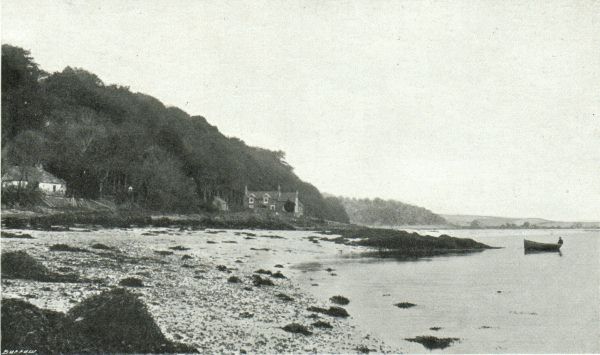
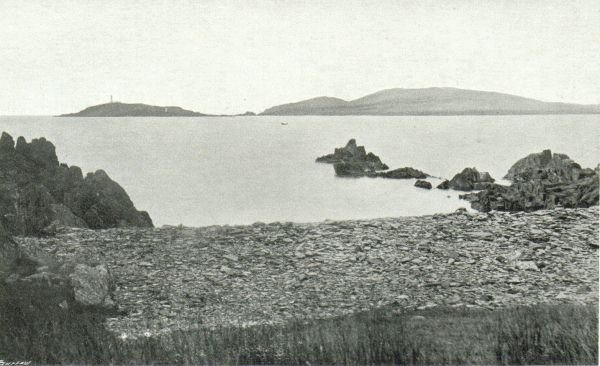
The journey by rail from Dumfries on the Glasgow & South-Western Railway is a pleasant one, the line running through Kirkgunzeon, Dalbeattie and Castle Douglas stations. Soon, the wide waters of the river Dee are seen, and the train slows down at the Kirkcudbright terminus.
By road, Kirkcudbright is nine-and-half miles from Castle Douglas, thirteen miles from Dalbeattie, and twenty-seven miles from Dumfries.
Among the numerous inlets which break up the southern coast line of Scotland, Kirkcudbright Bay is one of the most conspicuous. Vessels entering this bay, pass on the right, “Dirk Hatteraick’s Cave,” King William’s Battery, and on the left the Little Ross Lighthouse, Balmangan Bay, and a line of low hills close to the shore, ere rounding St. Mary’s Isle and reaching the new quay wall at Kirkcudbright town.
Concerning the origin of the place-name one writer remarks: St. Cuthbert (661) is said to have gone with some followers on business from Melrose, where he was Prior, to the land of the Picts. They arrived there the day after Christmas, expecting speedy return, for the sea was smooth and the wind favourable, but they had no sooner reached the land when a tempest arose, by which they were detained for several days,. exposed to hunger and cold: but they were by the prayers of the Saint supplied with food under a cliff where he was wont to perform his devotions during the watches of the night. On the fourth day the tempest ceased, and they were brought by a prosperous breeze to their own country. The traces of this visit have been left in the name of Kirkcudbright or ‘Church of Cuthbert.’ ” The site of the church which was dedicated to this saint is a little to the north of the town, and is now occupied as a cemetery.
POSITION AND GENERAL CHARACTER OF THE TOWN.
Situate on the estuary of the Dee, in the midst of pretty scenery and near to a sea-inlet of great beauty, Kirkcudbright has long been a resort of artists, and at one time seemed destined to form a “School” of its own.
The burgh is an excellent example of a quiet, thriving county town, and has an air of substantial respectability about it such as gives strangers good first impressions.
Houses and hotels are happily designed and carefully built, and the most exacting visitor cannot wish for better accommodation than that provided here.
As regards ” essentials ” – pure water, adequate and up-to-date sanitary arrangements, clean streets and high records of sunshine – Kirkcudbright is well favoured, and in these days of “hustle” is bent on making its virtues as a holiday resort better known.
Moreover, its inhabitants are of the opinion that if low rates, admirable educational facilities and almost unlimited opportunities for sport and recreation have any attraction for people on the look out for a nice place to settle down in, then Kirkcudbright should shortly have an accession to the number of its permanent residents. The town can boast imposing County Buildings, a quaint Mercat Cross, a handsome Parish Church, and a fine bridge over the Dee, and in Sr. Mary’s Gardens it has a charming public resort. The harbour and river are looked on with favour by boating men and fishermen, and within easy reach is an exceptionally sporting golf course of nine holes.
To those who have been forbidden to take much violent exercise, the delightful walks and drives to the many places of interest in the Kirkcudbright district will make a strong appeal; while to those bent on doing” this romantic neighbourhood by motor, the town will commend itself as a centre for enjoyable excursions.
WHAT TO SEE AT KIRKCUDBRIGHT.
The Bridge. The bridge which spans the Dee at Kirkcudbright is over 150 yards long, and is a favourite point of vantage from which to watch the races on Regatta Day. It commands charming views in all directions.
The Stewartry Museum. At one time Kirkcudbright was merely the eastern half of the province of Galloway, but Robert Bruce gave it the dignity and title of a Stewartry (that is, a district ruled by a steward of the King), the present county town being its capital. This will explain the name of the excellent Museum in St. Mary Street, where the collections are interesting and well-arranged. St. Mary Street is shaded by fine trees and leads to the beautiful St. Mary’s Gardens, overlooking the river and harbour. These are laid out with great taste and skill and are open to visitors. In these delightful grounds the wealth of foliage is wonderful, and exquisite glimpses of gleaming water are obtained through the trees.
Hard by is the Moat Brae another favourite resort with residents and visitors.
The Town Hall, which is close to the Parish Church and the Bowling Green, contains a much-appreciated Library and Reading-room the latter supplied with the best newspapers and magazines.
The Old Tolbooth, which forms so conspicuous and beautiful a feature in the High Street, has a spire, the materials for which are said to have been obtained from Dundrennan Abbey, seven miles away. The main part of the building was erected in Tudor times, and the Mercat Cross in front of the Tolbooth dates from 1504.
Maclellan’s Castle. “The Castle built in 1570 by Sir Thomas Maclellan of Bombie is still standing a ruined, picturesque feature of Kirkcudbright town. Greyfriars’ Church, where the family had its burial vault is in close proximity, and the part commonly called the Old Aisle covers the Maclellan Vault. The monument of the Sir Thomas who built the Castle, and of his wife, Lady Grizel Maxwell, is also to be seen there, erected by their son Robert, Lord Kirkcudbright.” (Scotland, Historic and Romantic.)
The War Memorial, situated in a commanding position in front of the Castle of the Mclellans, is a splendid specimen of the sculptor’s art, and is reckoned one of the finest in Scotland. Designed by Mr. G. H. Paulin, A.R.S.A., it takes the form of a gigantic warrior in bronze, seated, with sword in hand, and a child nestling at his knees, the conception-a fine one–being that of Britain defending the weak. The memorial, unveiled in April of 1921, by Colonel R. F. Dudgeon, C.B., of Cargen, the Lord Lieutenant of the County, is provided with four bronze panels, bearing the names of the fallen, and stands on a pedestal of rugged stones from the seashore.
The Castle Dykes. Kirkcudbright could boast of a castle long before the fortress mentioned above was built. Nothing remains of this, however, save some mounds called Castle Dykes, near the river.
The Academy. This, the premier educational establishment in the county, was founded circa 1576, and a brother of Samuel Rutherford, of Anwoth fame, was one of its early Rectors. Elementary and Secondary education on up-to-date lines is imparted at the Academy and the equipment of the Science and Art Department is exceptionally good. By means of scholarships and bursaries talented pupils may enter the Universities from the Academy.
The Embankment Walk, familiar to Kirkcudbright folk as ” the Bank,” was constructed “when George III. was king,” and a year before William IV. died it was considerably improved, thanks to the praiseworthy efforts of the Town Council. Today “The Bank” is one of Kirkcudbright’s legitimate sources of pride. It runs in a line with the Dee for a distance of three miles or more, and affords charming views of richly-wooded and diversified country.
The Old Churchyard. This ancient cemetery lies a little way out of the town and is entered by means of a picturesque gateway. Among the many memorials here is that to Billy Marshall, the gipsy. The inscription on the stone states that he lived to the “advanced age of 120 years” Billy belonged to the guild of Hammermen, which conducted his funeral in 1792, and refused to allow Lord Selkirk to participate because he was not an incorporated member of that body.
SPORT AT KIRKCUDBRIGHT.
Angling. Permission to fish for salmon in the Dee must be obtained from the lessee (Sir C. D. Hope-Dunbar, Bart., of St. Mary’s Isle), as the waters are strictly preserved. Tickets can be obtained from Mr. Davis, Factor, at The Grange. These tickets (one guinea for use of rod, 5s. day ticket) are available for a stretch of water between the railway bridge and the biscuit factory. There are numerous streams in the vicinity of the town that yield good trout fishing at a moderate cost.
Boating. The proximity of the estuary and of the Bay is undoubtedly the greatest of Kirkcudbright’s natural advantages. Good, reliable rowing-boats can be obtained for the hour, day or week at very moderate charges. The services of boatmen can be secured, if desired. Local boating enthusiasts arrange an annual regatta in connection with the annual sports, and excited crowds watch the various races, from the bridge and elsewhere, on this occasion.
Bowls. Members of the Bowling Club use the capital green near the Town Hall. Visitors are welcomed and pay reduced fees for temporary membership.
Cycling. As will be seen from the motor and cycle runs given later on, the roads in the Kirkcudbright district present no terrors to the traveller on wheels, whether they be two or four in number.
Golf. The 9-hole course played over by members of the Kirkcudbrightshire Golf Club is within five minutes’ walk of the station, and is nearly one-and-half miles in circuit. The scenery all round is beautiful in the extreme and well calculated to soothe the mind of the man who has “foozled” his shot or is badly “bunkered.” The club has a ladies’ branch, and the fees are-Annual subscription, Gentlemen, 25s.; Ladies, iSs. Visitors : ls. per day, 4s. per week, 7s. per fortnight, and 10s. per month.
RAMBLES IN THE IMMEDIATE VICINITY OF THE TOWN.
St. Mary’s Isle, to the south of the town, is really only a peninsula. On it once stood a twelfth century Priory dedicated to St. Mary-hence the name. A house formerly standing on this strip of land was the home of Lord Daer, son of the Earl of Selkirk, and a friend and admirer of Burns, and it was here that the poet composed the Selkirk Grace:
“Some ha’e meat and canna eat,
And some wad eat that want it;
But we ha’e meat and we can eat,
And sae the Lord be thankit.”
The present mansion is the seat of Captain Hope, and he kindly allows visitors who have signed their names in the book at the Lodge to look over the beautiful grounds. The” Isle ” is associated with yet another interesting personality – to wit, Paul Jones, “the bad, bold buccaneer,” who was born at Arbigland, about thirty miles east of Kirkcudbright, and was adopted by his brother-in-law who had gone to America, and taken the name of Jones. After being in the merchant service, first of England and then of America, Paul entered the American Navy in 1775. Three years later, when in command of the frigate ” Ranger,” he sailed into Kirkcudbright Bay, hoping to capture and carry off’ the Earl of Selkirk. The Earl, however, was absent from home, and the men sent to bring him off to the ship demanded the plate instead, which the Countess hastily gave them ; her own account in a private letter written a few days later to William Craik, of Arbigland, is given in Mr. Harper’s Rambles in Galloway.
The plate was afterwards brought back by Jones, and returned to the Countess with apologies. In the following autumn this unusual type of “freebooter” performed exploits – notably in the action between the “Bon Homme Richard” and the “Serapis “- which place him among the great naval commanders of the world. (Scotland, Historic and Romantic.)
Black Murray or Black Morrow Wood is reached from the eastern side of the harbour and owes its name to the reputed capture, within its recesses, of a bandit- Black Murray. The story runs that young Maclellan of Bombie filled the basin of a spring with spirits (the Black Morrow Well) and the outlaw, having drunk of if freely, soon fell into a stupor, whereupon Maclellan chopped off his head, brought it on the point of his sword to King James II., and so secured the promised reward.
Passing through the Black Murray Wood we catch glimpses of St. Mary’s Isle (right) and the wood bearing the pleasant name of ” Paradise ” on the left. At Mutehill, we leave the main highway and branch off along a road near the shore. This presently brings us to Lake Wood (where we sign the book at the lodge), which runs in a line with the coast opposite Senwick Woods and the Ross Lighthouse.
If so inclined, we might proceed southwards in order to see the remains of King William’s Battery- a reminder of William III’s preparations for his Irish campaign and (on the coast) Dirk Hatteraick’s Cave- named after a character in Scott’s Guy Mannering – but on this occasion we turn in the direction of Balmae, and climb the steep path in order to gain a magnificent view over the waters of the Solway and of the Wigtownshire coast-line.
Lochfergus. Lochfergus lies almost due east of Kirkcudbright and is reached either by the road which runs in a north-easterly direction to Dalbeattie, or by a pleasant footpath ramble by way of Barrhill, through the woods of Kirkland, and finally by the fields. The “Loch” exists no longer, but its site is a large meadow in which a mound bears the suggestive name of Palace Isle. The walk could be lengthened by turning to the right just beyond the “Loch” and making for Glen-Ley, a charming retreat made musical with the sound of running water. Presently, at Buckland Bridge, we enter the Kirkland Road, and bearing to the right soon get back to Kirkcudbright.
Tongland. Tongland, or Tongueland, as it is sometimes spelt, is situate a little over two miles northeast of Kirkcudbright, and is accessible by a good main road which, a little way out of the town, is carried across the Dee by Telford’s Bridge. Higher up is the picturesque Old Bridge, near to which are the placid depths of the Linn Pool, and the “rapids “called the “Doachs” – both worthy subjects for the photographer’s plate. Tongland Parish Church stands on the site of a Cistercian Abbey, and is reached from the old bridge by a pleasant footpath on the left bank of the Dee.
By way of variety, we may return to Kirkcudbright along the river embankment.
PLACES OF INTEREST FURTHER AFIELD.
Burnfoot, Dundrennan Abbey, etc. A very pleasant circular tour may be taken through Galtway and Burnfoot to Dundrennan Abbey, and back along the Bombie Road. At Burnfoot Mary, Queen of Scots, after passing the night at Dundrennan Abbey, committed the fatal mistake of putting herself into the hands of Elizabeth by crossing Solway Firth.
The sails were hoisted, the oars were plied, the vessel went freshly on her way through the firth which divides the shores of Cumberland from those of Galloway, but not till the vessel diminished to the size of a child’s frigate did the doubtful and dejected and dismissed followers of the Queen cease to linger on the sands; and long, long could they discern the kerchief of Mary, as she waved the oft-repeated signal of adieu to her faithful adherents, and to the shores of Scotland.” (“The Abbot.”)
The shore scenery to the north-east and south of Burnfoot is grand, and the Cumberland coast and mountains opposite show up well when the air is clear. Regaining the road and proceeding due north, we soon reach Dundrennan Abbey (Cistercian), which in many ways resembles that of Glenluce. The Abbey was founded in the middle of the twelfth century, and is in the Transitional style of architecture-Gothic alterations having been introduced into the Norman building.
The Wizard, Michael Scott, is said to have lived at Dundrennan for some time, and to have “shut up the plague in one of the vaults, so that, although it contained a number of valuables, everyone was afraid to open the door lest the pest should rush forth and grip the district.”
The “Commendator” at the head of the establishment when Queen Mary arrived at the Abbey after her long ride from Langside (May 13th, 1568) was Edward Maxwell. He gave away the greater part of the Abbey lands, and James VI. having seized the revenues in 1621, the buildings were allowed to fall into decay, though the Church was used for Protestant services for nearly a century afterwards. In 1838, repairs were carried out by the Earl of Selkirk, and, in recent years, the Abbey has been taken under the care of the Government. Among the numerous tombstones within the Abbey is one to ” The Belted Knight “-supposed to be Alan, Lord of Galloway, great-grandson of Fergus, the father of Devorgilla, buried in Dundrennan in 1233.
Returning to Kirkcudbright after seeing these most interesting ruins, we pass through Bombie Glen, near to which once stood the home of the lords of the manor.
Kirkandrews (9 miles) lies on the other side of the Bay, and is reached through Kirkchrist, then alongside the shore for awhile, with entrancing views opening up as we go, and finally to the right through Borgue (the hill is a stiff one, hut the views from the top are grand).
The kirkyard at Kirkandrews contains several tombstones marking the resting-place of “men of the Covenant.”
Laurieston (12 miles). We journey northwards this time, turning left at Tongland Bridge, and keep alongside the river Tarff through an exquisite valley. Turning to the left at Ringford, and still keeping close to the river, we soon have Kirkconnel Moor and Linn on the left, and a little further, on the same side, the Martyrs’ Monument – an obelisk marking the grave of five Covenanters, done to death in “the killing times.” The road now runs straight ahead – and due north past Giant’s Dyke and Bargatton Lake (on the right) and the Druid Circle (on the left) until finally we come to Laurieston, all round which place the scenery is extremely beautiful. Three miles from Laurieston, and reached over a stiff hill is Lochenbreck, famous for its Spa, Hotel and Loch.
MOTOR AND CYCLE RUNS.
Kirkcudbright to Castle Douglas (9.5 miles). An easy ascent to Tongland, then undulating to Bridge of Dee, thence almost level into Castle Douglas, near to which is the beautiful Carlingwark Loch. Boats on this fine sheet of water are available for 6d. an hour.
Also near Castle Douglas, and worth seeing while in this district, is Threave Castle (reached through Buchan and the Mains of Kelton Farm in two-and-half miles). It was built by Earl Archibald Douglas, commonly known as “the Grim,” and was reached by a ford which crossed the eastern branch of the river to the south end of the island. The ruin is in a fair state of preservation and over the entrance may be seen a stone corbel called the “Gallows’ Knob,” from which the Earl was fond of hanging anyone who displeased him.
Kirkcudbright to Dalbeattie (13 miles) and Dumfries (27 miles). The usual route to Dumfries is through Castle Douglas, but we shall be well advised in taking “the low road ” through Dalbeattie, for near that town are the following objects of interest : The river Urr, winding in and out amid charming scenery; the Plantain Loch ; the ruined Castle of Buittle (reached over Buittle Bridge), the extraordinary artificial mound called the Moat of Urr (on the road to Haugh of Urr) the beautiful cascade called the Spottes Linn ; and the uplands which command such lovely and extensive views.
From Dalbeattie an undulating road takes us through Edingham (l4.5 miles), Corra (17 miles), Lochenhead (21 miles), Woodfoot (23.5 miles), and the suburb of Maxwelltown, into Dumfries. The Observatory and Museum on Corbelly Hill, Maxwelltown, are well worth seeing (admission, Saturdays 3d., other days 6d.) and in Dumfries the two bridges over the Nith, the Burns Statue at the top of High Street; Greyfriars Church, St. Michael’s Churchyard (containing the Burns Mausoleum) and the Burns Walk beside the river are exceedingly interesting. Seven miles to the south of Dumfries, and reached by a good road, is Sweetheart or New Abbey (called New to distinguish it from the Abbey at Dundrennan). The road, after Maxwelltown has been left behind, has fair surface past Islesteps to the foot of Whinnyhill (where- a turn to the left should be taken). From the summit of the hill grand views are obtained, and the rest of the journey is accomplished with ease, the road, as New Abbey is approached, running under a delightful avenue.
Sweetheart Abbey is a magnificent old ruin, said to be the finest of its kind in Scotland, and is in a remarkable state of preservation. It was founded by Lady Devorgilla, wife of John Baliol (one authority says in 1275, another in 1284), for the purpose of enshrining her husband’s heart, which she caused to be embalmed and placed in an ivory casket and entombed in Sweetheart’s holy fane. This saintly Galloway lady died at Barnard Castle in 1289, at the age of 76, and was buried here in the same tomb with her husband’s heart. The mountain called Criffel (2,000 feet) is a prominent feature in the landscape near the abbey.
From New Abbey we could get back to Kirkcudbright either by the long circuit through Kirkbean to Dalbeattie, or by the road that runs north-west through Barlay, Auchengray, and past Lochend into the main road from Dumfries, where we should turn to the left and journey through Corra, Edingham and Dalbeattie homewards.
Kirkcudbright to Gatehouse (8.5 miles). Gatehouse, or Gatehouse-of-Fleet, to give its full name, lies to the north-west of Kirkcudbright, and after the first mile of almost level road there are long hills to climb to Minto (four miles), followed by almost as long a descent. As the town is approached, we get an incomparably lovely view of the Fleet Valley, and of Wigtown Bay and the Isles of Fleet in the distance. To the south of Gatehouse, and within easy reach, are the beautiful grounds of Cally House, and slightly to the south-west of the town is Anwoth Kirk–ever to be associated with the saintly Samuel Rutherford.
Kirkcudbright to New Galloway (18.75 miles). The route has already been described as far as Laurieston, beyond which an easily-undulating road brings us past Blates Mill, Parkhill, New Gal]oway Station, Bennan (15 miles) and Lochside (16 miles), to the foot of a short hill leading into New Galloway. The surface for the last five miles is, in dry weather, very poor, and in wet weather shocking. New Galloway is a pretty and
“rising ” (in more senses than one) place, and is situate in the centre of a district vividly described in novels by the late Mr. S. R. Crockett, whose birthplace, by the way, was Duchrae Farm, close to New Galloway Station.
